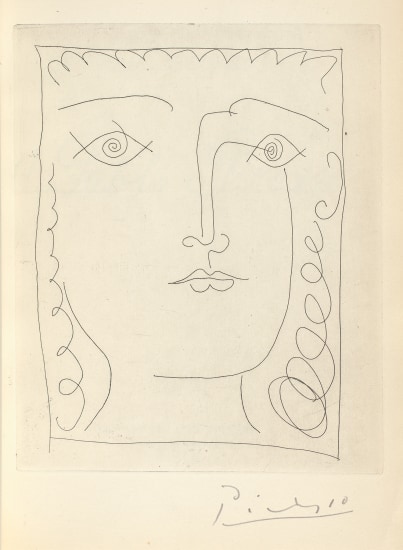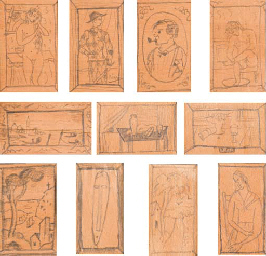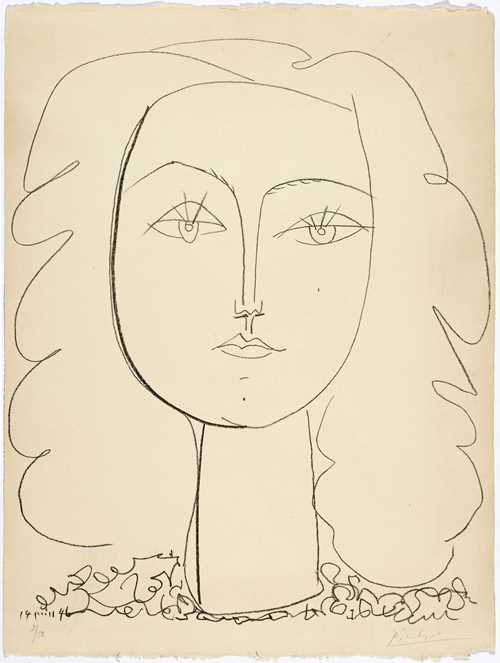PROPERTY FROM A DISTINGUISHED PARIS COLLECTION PABLO PICASSO (1881-1973) Tête de picador au nez cassé stamped with the foundry mark 'C. VALSUANI CIRE PERDUE' and numbered '3/6' (verso) bronze with dark brown patina 18.5cm (7 5/16in) high. Conceived in Barcelona in 1903, this bronze version cast in 1960 by the Valsuani Foundry in an edition of 8 numbered 00 to 6/6 plus one unnumbered cast. Fußnoten The authenticity of this work has kindly been confirmed by Monsieur Claude Picasso. Provenance Galerie Louise Leiris, Paris. Marlborough Gallery, New York. Caral Gimbel Lebworth Collection (acquired from the above); her sale, Christie's, New York, 7 May 2009, lot 313. Acquired at the above sale by the present owner. Literature R. Penrose, The Sculpture of Picasso, exh. cat., New York, 1967 (another cast illustrated p. 51). W. Spies, Picasso Sculpture, London, 1972 (another cast illustrated p. 30). A. E. Elsen, Origins of Modern Sculpture: Pioneers and Premises, London, 1974 (another cast illustrated). R. Johnson, The Early Sculpture of Picasso 1901 - 1914, New York & London, 1976 (another cast illustrated pp. 191-192). W. Spies, Picasso, das plastische Werk, Stuttgart, 1983 (another cast illustrated pp. 19 & 326). J. Pilau i Fabre, Picasso, Life and Work of the Early Years, 1881 - 1907, Oxford, 1985 (another cast illustrated p. 361). W. Spies, Picasso, Sculpteur, exh. cat, Paris, 2000 (plaster version illustrated p. 25 & another cast illustrated p. 346). W. Spies, Picasso, The Sculptures, Stuttgart, 2000 (plaster version illustrated p. 25 & another cast illustrated p. 346). A. Temkin & A. Umland, Picasso, Sculpture, exh. cat., New York, 2015 (another cast illustrated p. 45). C. Bernardi, S. Molins & L. Le Bon, Picasso, bleu et rose, exh. cat., Vanves, 2018 (another cast illustrated p. 198). The present work Tête de picador au nez cassé secures an important place in Picasso's sculptural oeuvre, as it was created in the Blue Period. This period, between 1901 and 1904, was paramount within the artist's body of work as Picasso cultivated his personal artistic voice and left the academic tradition behind. Picasso began to capture human agony and the struggle of everyday life, often depicting crippled figures and turning towards the hopeless and outcasts as favoured subjects. Tête de picador au nez cassé is Picasso's first endeavour in translating these concepts into his sculptures. The facial characteristics of the bullfighter, an iconic subject Picasso would return to time and again, are distorted in the present work. The tip of the nose, clearly broken, directs towards the lower right, and the left side of the mouth curls downwards. The reflections caught on the brown patina on the uneven surface of the mask create contrasting light and shadow effects, where deep lines and rough facial expressions come to life. As the son of a painter, Picasso's desire to become an artist emerged from a young age. When he was only 16 years old, Picasso went to the Instituto da Guarda in La Corūna, followed by two other art academies in Barcelona and Madrid between 1894 and 1895. His education was mainly focused on drawing and painting, and followed the academic discipline. During this time, Picasso was very much isolated from the trends that were growing in Europe. It was not until a few years later in 1899, when he became acquainted with Spanish sculptors such as Francisco 'Paco' Durrio y Madrón, that he became aware of the tantalising developments beyond academy life. Durrio y Madrón was a disciple of Paul Gauguin who introduced new forms, materials, techniques and context to sculpture. Alongside his appreciation of non-Western art, Gauguin's formal experiments in three dimensions would later have a profound influence on Picasso's work. In 1899, Picasso joined the anarchists from the Barcelonan Els Quatre Gats café, the equivalent of Le Chat Noir in Paris. The Symbolist artists and poets who gathered there closely followed the radical changes that we
PROPERTY FROM A DISTINGUISHED PARIS COLLECTION PABLO PICASSO (1881-1973) Tête de picador au nez cassé stamped with the foundry mark 'C. VALSUANI CIRE PERDUE' and numbered '3/6' (verso) bronze with dark brown patina 18.5cm (7 5/16in) high. Conceived in Barcelona in 1903, this bronze version cast in 1960 by the Valsuani Foundry in an edition of 8 numbered 00 to 6/6 plus one unnumbered cast. Fußnoten The authenticity of this work has kindly been confirmed by Monsieur Claude Picasso. Provenance Galerie Louise Leiris, Paris. Marlborough Gallery, New York. Caral Gimbel Lebworth Collection (acquired from the above); her sale, Christie's, New York, 7 May 2009, lot 313. Acquired at the above sale by the present owner. Literature R. Penrose, The Sculpture of Picasso, exh. cat., New York, 1967 (another cast illustrated p. 51). W. Spies, Picasso Sculpture, London, 1972 (another cast illustrated p. 30). A. E. Elsen, Origins of Modern Sculpture: Pioneers and Premises, London, 1974 (another cast illustrated). R. Johnson, The Early Sculpture of Picasso 1901 - 1914, New York & London, 1976 (another cast illustrated pp. 191-192). W. Spies, Picasso, das plastische Werk, Stuttgart, 1983 (another cast illustrated pp. 19 & 326). J. Pilau i Fabre, Picasso, Life and Work of the Early Years, 1881 - 1907, Oxford, 1985 (another cast illustrated p. 361). W. Spies, Picasso, Sculpteur, exh. cat, Paris, 2000 (plaster version illustrated p. 25 & another cast illustrated p. 346). W. Spies, Picasso, The Sculptures, Stuttgart, 2000 (plaster version illustrated p. 25 & another cast illustrated p. 346). A. Temkin & A. Umland, Picasso, Sculpture, exh. cat., New York, 2015 (another cast illustrated p. 45). C. Bernardi, S. Molins & L. Le Bon, Picasso, bleu et rose, exh. cat., Vanves, 2018 (another cast illustrated p. 198). The present work Tête de picador au nez cassé secures an important place in Picasso's sculptural oeuvre, as it was created in the Blue Period. This period, between 1901 and 1904, was paramount within the artist's body of work as Picasso cultivated his personal artistic voice and left the academic tradition behind. Picasso began to capture human agony and the struggle of everyday life, often depicting crippled figures and turning towards the hopeless and outcasts as favoured subjects. Tête de picador au nez cassé is Picasso's first endeavour in translating these concepts into his sculptures. The facial characteristics of the bullfighter, an iconic subject Picasso would return to time and again, are distorted in the present work. The tip of the nose, clearly broken, directs towards the lower right, and the left side of the mouth curls downwards. The reflections caught on the brown patina on the uneven surface of the mask create contrasting light and shadow effects, where deep lines and rough facial expressions come to life. As the son of a painter, Picasso's desire to become an artist emerged from a young age. When he was only 16 years old, Picasso went to the Instituto da Guarda in La Corūna, followed by two other art academies in Barcelona and Madrid between 1894 and 1895. His education was mainly focused on drawing and painting, and followed the academic discipline. During this time, Picasso was very much isolated from the trends that were growing in Europe. It was not until a few years later in 1899, when he became acquainted with Spanish sculptors such as Francisco 'Paco' Durrio y Madrón, that he became aware of the tantalising developments beyond academy life. Durrio y Madrón was a disciple of Paul Gauguin who introduced new forms, materials, techniques and context to sculpture. Alongside his appreciation of non-Western art, Gauguin's formal experiments in three dimensions would later have a profound influence on Picasso's work. In 1899, Picasso joined the anarchists from the Barcelonan Els Quatre Gats café, the equivalent of Le Chat Noir in Paris. The Symbolist artists and poets who gathered there closely followed the radical changes that we


.jpg?w=400)
.jpg?w=400)
.jpg)


.jpg?w=400)

.jpg)
.jpg)



.jpg?w=400)
Try LotSearch and its premium features for 7 days - without any costs!
Be notified automatically about new items in upcoming auctions.
Create an alert